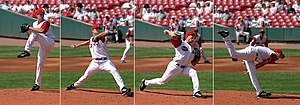------------------------------------------------
Squash and stretch
The most important principle is "squash and stretch",[4] the purpose of which is to give a sense of weight and flexibility to drawn objects. It can be applied to simple objects, like a bouncing ball, or more complex constructions, like the musculature of a human face.[5][6] Taken to an extreme point, a figure stretched or squashed to an exaggerated degree can have a comical effect.[7] In realistic animation, however, the most important aspect of this principle is the fact that an object's volume does not change when squashed or stretched. If the length of a ball is stretched vertically, its width (in three dimensions, also its depth) needs to contract correspondingly horizontally.[8]
[edit]Anticipation
Anticipation is used to prepare the audience for an action, and to make the action appear more realistic.[9] A dancer jumping off the floor has to bend his knees first; a golfer making a swing has to swing the club back first. The technique can also be used for less physical actions, such as a character looking off-screen to anticipate someone's arrival, or attention focusing on an object that a character is about to pick up.[10]
For special effect, anticipation can also be omitted in cases where it is expected. The resulting sense of anticlimax will produce a feeling of surprise in the viewer, and can often add comedy to a scene.[11] This is often referred to as a 'surprise gag'.[12]
------------------------------------------------


No comments:
Post a Comment